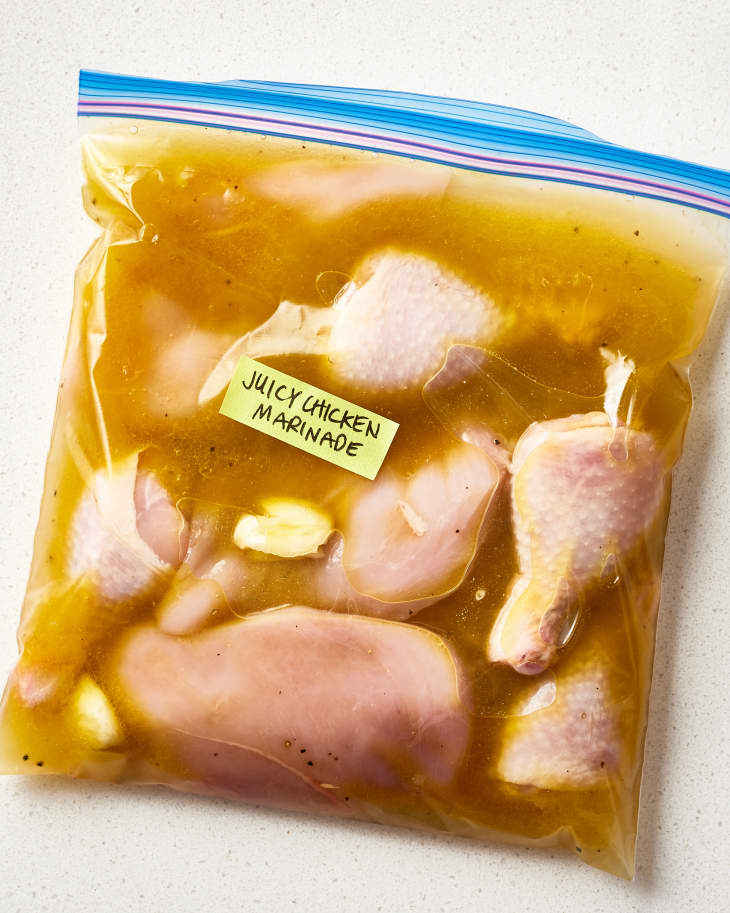How to Make a Quick Brine with Salt & Water for More Tender Meat
When most people think of brining, they picture brining a whole Thanksgiving turkey, but it’s such a great technique that we’ve started using it all year round for all sorts of different meats and even vegetables like cauliflower. We like to throw pork chops and chicken breasts in a quick brine for extra oomph before continuing on with the rest of the recipe.
Brining is also a great technique if you are cooking a smaller portion of turkey, such as a turkey breast, for Thanksgiving or even for weeknight dinners. And although many brining recipes call for brining for at least 12 hours, a much shorter brine can also deliver flavorful, moist meat. In fact, a quick brine of just 30 minutes is enough to add flavor to smaller cuts like chicken breasts.
What Is Brining?
Brining is the process of submerging a cut of meat in a brine solution, which at its most basic is simply salt dissolved in water. A brine can also be seasoned with dried herbs and spices. The meat absorbs some of the liquid and salt, resulting in a juicier and more flavorful final dish. This technique is particularly great for lean cuts of meat that tend to dry out during cooking (that’s why it’s so popular with turkey).
Is Brining Essential?
If you are short on time or fridge space, you might be wondering if you can skip brining. While there are scientific reasons for brining, it’s not the only way to produce flavorful meat. If dealing with liquid is what’s putting you off of brining, consider a dry brine. There are other options, too, like rubbing butter and seasonings under the skin of turkey or chicken. Try it in this turkey breast recipe. But we think you should give brining a try — and it’s easy with the basic brining ratio and method we’ve outlined below.
What Is the Brine Ratio?
The basic ratio of salt to water for a brine is 4 tablespoons of kosher salt per 1 quart (4 cups) of water. If you are using fine table salt, reduce the amount to 3 tablespoons. Keep in mind, also, that different kosher salt brands vary in how salty they actually are. When in doubt, cut down on the amount of salt or the amount of time you brine the item.
Step-by-Step Quick Brining Guide
- In a container large enough to hold your meat (and preferably with a lid to avoid sloshing), dissolve the salt in the water. Stir in any seasonings you’d like to add (see below for suggestions).
- Add your meat. If there’s not quite enough liquid to cover, add a solution of 1 cup of water and 1 tablespoon of kosher salt (or 3/4 tablespoon of fine table salt) until the meat is completely submerged.
- Cover the container and refrigerate. Smaller cuts like pork chops and chicken breasts can be brined for as little as 30 minutes to an hour, while a turkey really needs at least 12 hours.
- Remove the meat from the brine, pat it dry, and continue with your recipe. Brining makes the biggest difference for dry heat preparations like roasting and grilling. The flavor and texture difference isn’t as great when braising and poaching in liquid. Just be sure to take into account the extra salt from the brine when you are seasoning your final dish.
Quick Brine Flavoring Ideas
To infuse your meat with extra flavor, throw some extra spices and aromatics into your brine that will complement the finished dish. Making our Pork Stir-fry with Asparagus and Sugar Snap Peas? Try adding a few slivers of ginger into the brine. For roasted chickens, add lemon rind and a few sprigs of rosemary or thyme. Some folks also like adding sugar (about 2 tablespoons per quart) into the brine to lightly sweeten the meat.
Do you brine your meat? What’s your favorite recipe?
